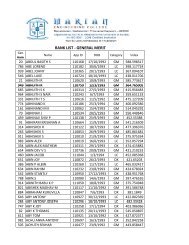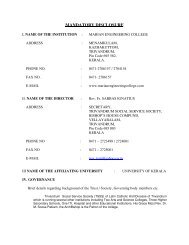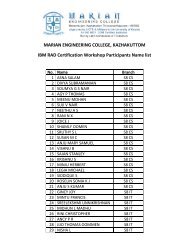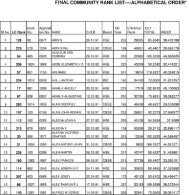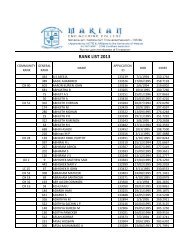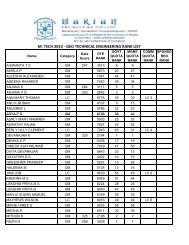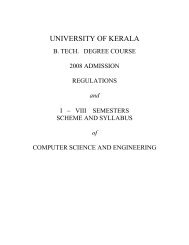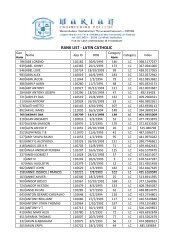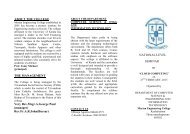UNIVERSITY OF KERALA - College of Engineering, Trivandrum
UNIVERSITY OF KERALA - College of Engineering, Trivandrum
UNIVERSITY OF KERALA - College of Engineering, Trivandrum
You also want an ePaper? Increase the reach of your titles
YUMPU automatically turns print PDFs into web optimized ePapers that Google loves.
08.705.11 Elective-III HIGHWAY AND AIRFIELD<br />
PAVEMENT MATERIALS<br />
L T P/D Cr<br />
3 1 0 4<br />
Module - I<br />
Properties <strong>of</strong> component layers; different types and role played by them in flexible/rigid pavement.<br />
Mechanical response <strong>of</strong> soil and the different consititutive models, different laboratory procedures for<br />
evaluating the mechanical properties <strong>of</strong> soils.<br />
Road making aggregates - classification, properties <strong>of</strong> aggregates, design <strong>of</strong> aggregate gradation.<br />
Module - II<br />
Bituminous road binders - penetration grading, viscosity grading, emulsions, cut backs and modified binders.<br />
Rheology <strong>of</strong> bituminous binders, modified binders, aging <strong>of</strong> bitumen.<br />
Bituminous mixtures, Mix design- Marshall method and Superpave procedure, Design <strong>of</strong> emulsified mixes,<br />
requirements, properties, tests for characterization, Influence <strong>of</strong> aggregate, binder type on bituminous mixtures,<br />
mechanical properties.<br />
Issues in constitutive modelling <strong>of</strong> binders, Introduction to linearized viscoelastic behaviour, behaviour during<br />
fatigue, creep loading conditions, resilient modulus <strong>of</strong> pavement materials.<br />
Module -III<br />
Portland cement and cement concrete for use in road works, Requirements <strong>of</strong> paving concrete.<br />
Design <strong>of</strong> mixes for recycling <strong>of</strong> bituminous and concrete pavement surfaces. Soil stabilization techniques.<br />
References:<br />
1. A. G. Correia, Flexible Pavements, A. A. Balkema Publishers, 1996.<br />
2. P. H. Wright, Highway <strong>Engineering</strong>, John Wiley & Sons, 1996.<br />
3. S. K. Khanna and C. E. G. Justo, Highway Material Testing, New Chand & Bros.,1999.<br />
4. Huang, Y.H. (2004). “Pavement Analysis and Design.” Pearson Prentice Hall, USA.<br />
5. G. N. Durhan, W. A. Marr, and W. L. DeGr<strong>of</strong>f, Resilient Modulus Testing for Pavement Components,<br />
ASTM International, U.S.A., 2003.<br />
6. S. E. Zoorob, A. C. Collop, and S. F. Brown, Performance <strong>of</strong> Bituminous and Hydraulic Materials in<br />
Pavements, A. A. Balkema Publishers, 2002.<br />
7. R. N. Hunter, Bituminous Mixtures in Road Construction, Thomas Telford Services<br />
Ltd., 1995.<br />
8. ASTM, Annual Book <strong>of</strong> ASTM Standards – Section IV, Vol. 04.03, ASTM International, 2002.<br />
9. D. Croney, and P. Croney, Design and Performance <strong>of</strong> Road Pavements, McGraw-<br />
Hill, 1998.<br />
Question paper:Duration : 3hrs<br />
The question paper consists <strong>of</strong> Part A and Part B.<br />
Part A is for 40 marks. There will be 8 compulsory short answer questions <strong>of</strong> 5 marks each covering the entire<br />
syllabus.<br />
Part B is for 60 marks. There will be two questions from each module. The candidate has to answer one<br />
question from each module. Use <strong>of</strong> IS 1343: 1980 and IS 456:2000 is permitted.<br />
Note: No charts, tables or other codes are permitted in the examination hall. If necessary, relevant data shall be<br />
given along with the question paper by the question paper setter.<br />
86



